Paschke Online
Designs Ink Publishing Article Archive and Reference Library
Articles by Chris A. Paschke, CPF GCF
Picture Framing Magazine
"Lightfastness, Color Permanence & Gold"
March 2024
Lightfastness is a product's resistance to change with exposure to light, primarily UV light. The degree of color permanence depends upon the specific medium being considered such as printing inks, color emulsions in photographs, matboard surface papers, fabrics, or artist pigments used for surface decoration. Lightfast means to hold its color for an acceptable period of time, as with matboards. Fugitive means to run away or disappear too quickly for consideration. Permanent generally means waterproof—not lightfast—when referring to paints, inks and felt pens. Acid free, and pH content, is often used in conjunction with describing papers and felt pens as art materials, and though important, does not come into play in this discussion.
Artwork, photographs, digital prints, matboards, and paper bevels are not the only sources of potential light fading or yellowing in conjunction with framing. Specialty papers and fabrics used to wrap mats, felt and metallic pens used for quick fix ruling lines and many bottled inks for calligraphy are often very light fugitive.
Light Review
Light is made up of photons in an electromagnetic field. Ultraviolet radiation referred to as UV light begins the low end of the spectrum up to 400 nanometers (nm), visible light is what allows us to see colors and is on the spectrum between 400 and 700 nm, and infrared radiation is found at levels of 700 nm and higher. Although statistics reflect UV light damage, many highly fugitive pigments are drastically affected and damaged by visible light in the middle of the light spectrum.
Visible light is what we need to register the actual colors of the color wheel, and the only way to protect pigments sensitive to visible light is to cover them so we can't see their color. Sometimes the very light that makes it blue is the light that will damage it. Papers sensitive to UV light damage may be helped by using UV filtering glazing, but pigments effected by visible light will not be helped. Acidic paper, which might be affected only by damaging UV rays may indeed be protected just fine, while certificates signed with fugitive inks susceptible to visible light will continue to fade.
Dyes as Colorants
When a basic color is created through the mixing of dyes, the colors are quite fugitive. Water-soluble dyes are generally not lightfast and will fade by exposure to visible light. Colored dyes are added during the initial papermaking or color mixing process. Felt pen and bottled fountain pen inks, tissue papers and many handmade rice papers are colored with these dyes also making them fugitive by nature. They were never intended for long term use, thus not requiring light permanence. (photo 1) Water-insoluble dyes are much more lightfast, often found as colors or patterns applied to existing papers. These are top sized to sheets affixed with alum as a bonding agent. (photo 2) Traditionally hand-marbled papers and pastepaper are good examples of pigmented colors used to create the patterns making them wonderfully lightfast. process and are considered quite lightfast.
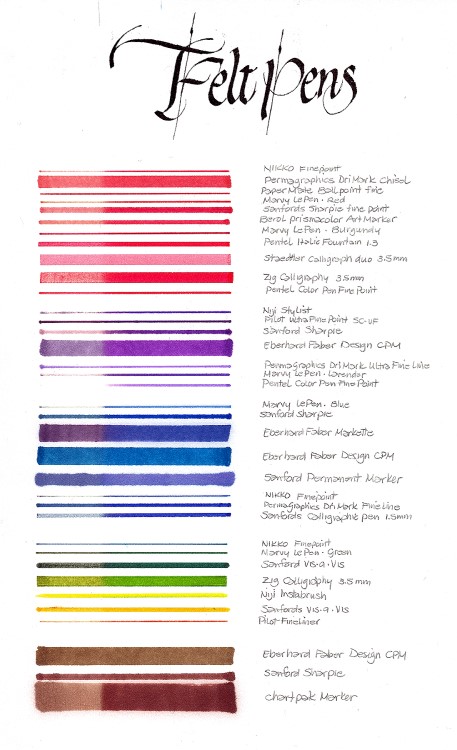 Photo 1
Photo 1
Colored felt pens were drawn, labeled, partially covered by a blocking board, and placed under UV light for two weeks, resulting in the left column fade. Though numerous pens have improved since this test, do not use colored pens without testing first.
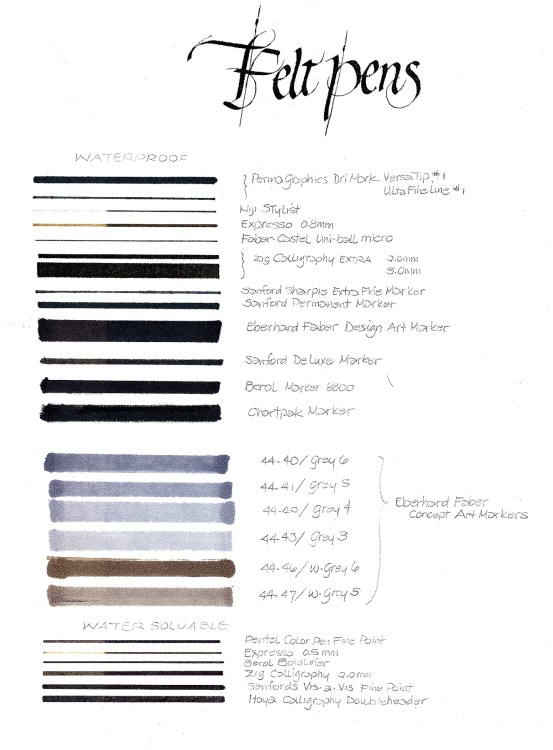 Photo 2
Photo 2
Both waterproof and water soluble black and gray pens were tested with a few showing fade in two weeks.
Pigments
Natural materials, though ground into pigment, are less lightfast than man-made ones. Roots, nuts and berries used to color inks throughout history are often considered stains rather than dyes, and fade as easily as flowers. Synthetics, such as acrylic, are chemically created and hold color well simply because of their non-organic origin, being plastics and don't break down.
Carbon based inks are pigmented with soot binders also making them very lightfast and the best choice for signing documents. On the other hand, permanent inks are made waterproof by the addition of shellac, not necessarily making them lightfast. Remember, permanent does not necessarily mean lightfast, only waterproof. Look for permanent and lightfast on product labels.
Many popular felt pens and nylon brushes—Sakura Pigma Micron, Faber-Castell, Winsor & Newton, Tombow, Copic—often used for illustration and sketching are noted as archival (meaning acid free), waterproof, and lightfast (sometimes only light resistant). Pigma fine point felt pens and brushes claim pigment ink, as waterproof and lightfast, though many state pigmented, light and water resistant, which is not the same. If the pen product or ink you wish to use does not refer to the ink being pigmented, waterproof, and lightfast, it probably isn't, and alcohol inks are an entirely different animal.
Inks
Sumi inks come bottled or in dry stick form and range from warm ivory black to cool jet blue-black. They are often quite lightfast but not waterproof. Fountain pen inks and many colored bottle inks for calligraphy are dye based and not lightfast, or waterproof. (photo 3) Some are, but again, test before you use them. Walnut ink is available as liquid and crystals. The crystals are reconstituted as needed as ink or paint and may be mixed any range from dense warm brown black to pale warm beige. Walnut is very lightfast, but not at all waterproof. As an artist I'm a huge fan, but not for framing.
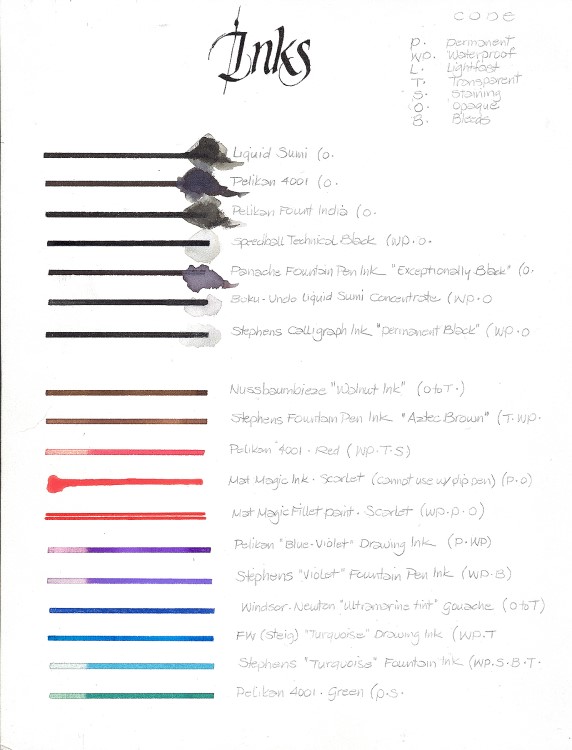 Photo 3
Photo 3
These were all inks from my own calligraphy studio at the time.
Metallics
Acrylics and tube metallic paints are more synthetic and do not appear to be affected when exposed to UV rays, and are often permanent, waterproof and lightfast. (photo 4) Metallic papers vary depending upon their composition and testing must be done to determine light permanence. Metallic felt pens and bronzing powders are another story. We have learned that real silver will tarnish over time, but synthetic silver inks stay bright and shiny even when exposed to UV rays. Unlike real gold, which holds its color, many gold inks are created by the addition of copper which will oxidize over time, turning green even if never exposed to light, it's an aging process stimulated more by time than light. Gold oil based felt pens, which come in many brands and sizes, will gradually turn from bright gold to orange to green to nearly black over a five year period, and have a bad habit of creating oil halos seeping away from the edges of a line. Warn artists and photographers from signing images with untested products, and NEVER to use them for a quick fix, ruling pen line on a mat.
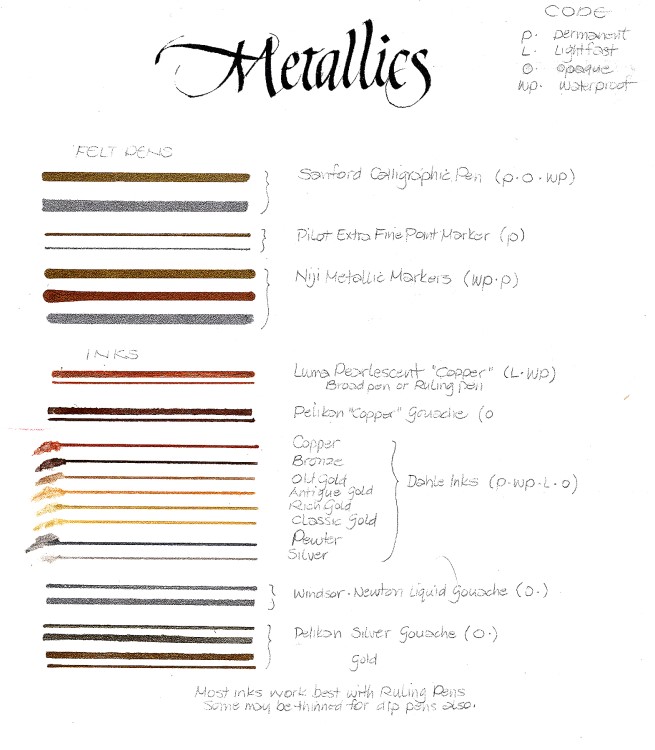 Photo 4
Photo 4
Liquid metallics can be fairly lightfast and waterproof.
A rose gold leaf original was perfectly color matched with a gold leaf fillet and moulding. After 10 years it became noticeable the gold frame dye colorant was fading from its rich warm gold to a harsh yellow gold, no longer matching the warm rose gold leaf art and fillet. (photo 5)
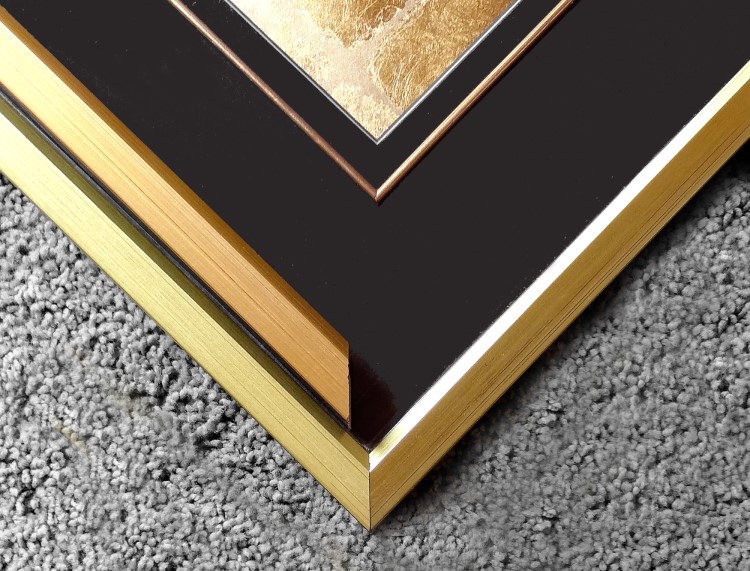 Photo 5
Photo 5
Note the faded yellow gold frame not longer matches the rose gold fillet and art.
Gold Pigment
Wet pigment gold lettering on black museum ragboard (photo 6), illustrates a series of metallic gouaches—Talens, Holbein and Winsor & Newton—gold sumi ink stick and pure shell gold all written with a 1mm dip pen nib. Compare the color variations of the golds. Metallic pigments are often created by beginning with a primary base color (red/yellow/blue) then adding metallic powders or mica to create their actual color tonality. Mica powder is a fine silvery powder which is often the key ingredient in many metallic gouaches and inks, and is what creates the pearlized sparkle which does not tarnish.
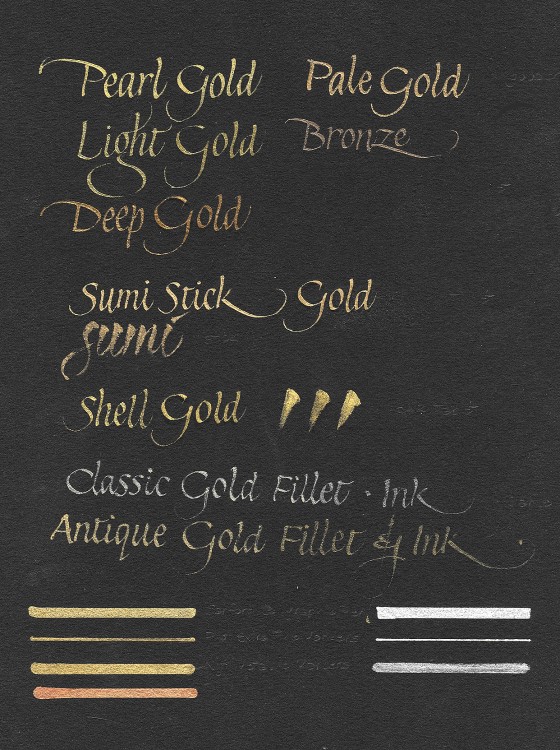 Photo 6
Photo 6
Top 5 are metallic gouaches (top), real gold sumi (center), inks (low center), oil based pens (bottom).
Warm based golds include the yellow based Pearl gold; red/orange based Deep gold; red based Sumi stick gold and Shell gold, though some have more base pigment which alters their actual end color. Cool golds include blue/green based light gold, as well as most bronze. Gold compatibility is vitally important when it comes to selecting a gold moulding, fillet or metallic matboard to complement a project. If a hand lettered or ruling pen gouache accent line of deep red gold is used at the mat opening for a certificate with a bold yellow gold embossed notary seal, the lettering will likely appear more orange than gold. Cool based or pigmented light gold notoriously appears green rather than gold at all when put in opposition with a warm based gold.
Gold Leaf
Whether pure 24kt leaf gold; pure shell gold tablet; gold metal leaf (which literally contains no gold at all); or the prepared wet pigments of bottled, tubed or stick gold inks; the color variations and applications can vary greatly. As a creative framing designer, it is imperative to understand the color variations available when dealing with gold, both wet and dry pigment, for juxtaposing two golds of different incompatible hues or bases side by side the design could be drastically altered, or simply one of the golds could appear a totally different color.
Gouache
Tube gouache (gwash) and watercolors often have permanency ratings stated on them (A, B, C, D) so staying within the the A, AA, or AAA permanency range is best. Gouache is a dependable, mixable, opaque watercolor, often confused with inexpensive poster paints and casein. Use tube paints wisely, as artist pigments may start off with high lightfast ratings becoming more fugitive when colors are mixed with them. Zinc White is designed to be used to tint colors, but Permanent White loses its color permanence rating when mixed, so pay attention. Many manufacturers have expanded their color lines with metallics, pearlescent and fluorescent colors in addition to the traditional palette. Often these colors are not considered lightfast and should be time tested for fading in a sunny window prior to considering use. Read the labels and verify through testing before framing use.
END
Copyright © 2024 Chris A Paschke
For more articles on mounting basics look under the mounting section in Articles by Subject.
Additional information on all types of mounting is found in:
The Mounting and Laminating Handbook, Second Edition, 2002,
The Mounting And Laminating Handbook, Third Edition, 2008 and
Creative Mounting, Wrapping, And Laminating, 2000 will teach you everything you need to know about getting the most from your dry mount equipment and materials as an innovative frame designer.
All books are available from Designs Ink Publishing through this website.
Chris A Paschke, CPF GCF
Designs Ink
Designs Ink Publishing
785 Tucker Road, Suite G-183
Tehachapi, CA 93561
P 661-821-2188
chris@designsinkart.com
 Photo 1
Photo 1 Photo 2
Photo 2 Photo 3
Photo 3 Photo 4
Photo 4 Photo 5
Photo 5 Photo 6
Photo 6